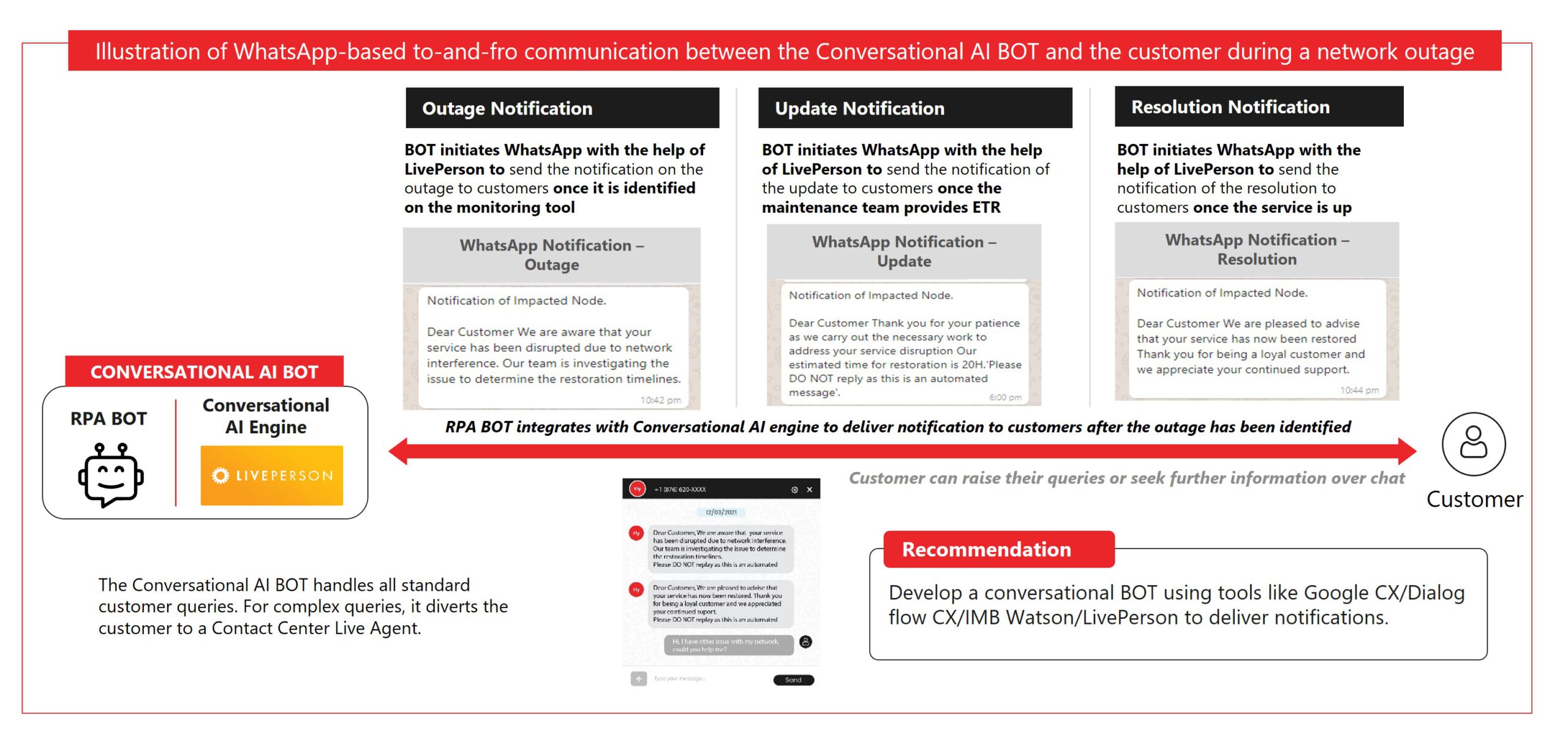
In the era of speed and consistency, many service providers in the connectedness industry deal with a significant number of calls related to network outages. Their inability to predict these outages and proactively notify the customer results in customer dissatisfaction.
Proactive outage notifications, if not triggered quickly, have a cascading impact:
- Huge call spike in contact center increases customer wait-time
- Customer dissatisfaction decreases NPS scores
- OpEx rises for the contact center
- Reputational loss increases the switching propensity of customers
To overcome these challenges and improve NPS, service providers must auto-identify the outages, and schedule notifications proactively. They need an intelligent central platform capable of orchestrating seamless conversations between the contact center and customers. This is established by implementing a “Two-way conversational Framework”. The steps involved are:
Step 1: Auto-identification of outage information
Build a unified outage monitoring dashboard to capture and categorize relevant outages. This is accomplished as shown:

Figure 1: Auto-identification of outage information
- Build an Outage Monitoring Dashboard: This solution pulls outage information capturing the node/device details from various monitoring systems
- Extract data from the Outage Monitoring Dashboard: RPA BOT fetches details of the impacted nodes from the Outage Monitoring Dashboard
- Update data to the outage database: RPA BOT updates the extracted details into the database where they can be validated, scheduled, monitored, and notified to the customers
Step 2: Schedule Notification
Perform automated validation of outages with the following entities:
Outage Database
- Use the RPA BOT to monitor and capture the Impacted Node ID/Device name in the outage database
- Validate the extracted information based on defined criteria using RPA BOT
- Leverage the extraction BOT to update the database and notify the Notification BOT
- Fetch the required details from the outage database using the Notification BOT to proceed further
CRM Database
Leverage RPA BOT to fetch customer contact details from the CRM database based on more information extracted from the Monitoring tool like Customer Name, Customer Contact Number
Field Technicians
Validate the outages by sending notifications to the relevant stakeholder and getting a confirmation, for example, confirming an outage with a technician from a particular region.
Post validation, use the RPA scheduler to organize and assign RPA BOTs to notify the impacted customers based on the Technology (Copper, Fiber, Cable), Impact frequency, and Geographical location.
Configure RPA BOT to trigger communications as below:
- Outage Notification – Send the notification once the service interruption is identified
- Update Notification – Send the notification based on the Estimated time to resolve (ETR) provided by the maintenance team
- Resolution Notification – Send the notification when the service is up
The diagram depicts the LivePerson conversational AI engine used to schedule notifications to customers.

Figure 2: Scheduling notifications using LivePerson
Step 3: Notify and engage with customers using a conversational AI BOT
Integrate RPA BOT with the conversational AI engine to deliver notifications to customers after the outage has been identified. It provides seamless updates to the end customers on the service interruption and resolution status. The bot can perform two-way conversations if the customer has additional queries using conversational AI.

Figure 3: Illustration of to-and-fro communication between Conversational AI Bot and customer during network outages
The conversational AI bot handles all simple and standard queries raised by customers like billing etc. For more complex questions, e.g., related to network issues, the Conversation AI Bot seamlessly transfers the query to a Live Agent without impacting the customer chat experience.
Recommendation: Develop a conversational BOT using tools like Google CX/Dialog flow CX/IMB Watson/LivePerson to deliver notifications.
In conclusion
With the successful implementation of the intelligent network outage prediction and two-way conversational AI framework, service providers in the connectedness industry can achieve the following benefits:
- 54% reduction in calls related to outages
- 25% reduction in the cost of the operations
- Boost agent productivity
- Improvement in NPS
I appreciate the efforts of my colleagues Munendra S, Karthick J, Manikandan R, Venkatesh P, and Deesha Chaware for their contributions and continuous support in compiling this article.
By Ramanan GV

Director – Delivery, Prodapt Solutions
Ramanan has 20+ years of experience in IT/ITES/Telecom Industry. His expertise spans Robotic Process Automation (RPA), Business Process Management and Voice Process optimization. Over the last 2 years, he has implemented 100+ Bots across O2A processes using multiple automation platforms to enable Digital Service Providers (DSPs) in their Digital journey. He is currently focusing on building and managing hybrid automation framework using RPA for business processes.
Prodapt is a leading digital transformation partner enabling DSPs in strategy, execution & sustenance, and delivering business outcomes over the past decade. Clients engage with Prodapt for their deep domain expertise in DSP vertical and hands-on execution experience of complex end-to-end transformation programs. The world’s leading wireline, wireless and broadband operators trust Prodapt as their partner of choice for their growth initiatives and to power their transformation programs.

